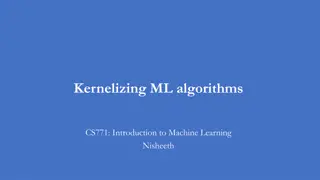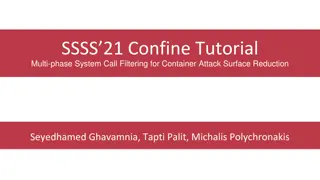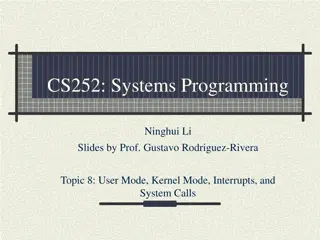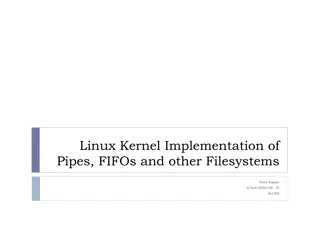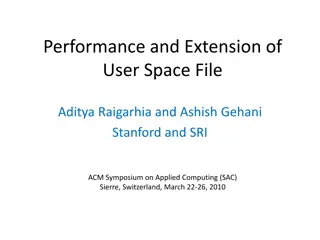
Kernel Synchronization and Race Conditions in Operating Systems
Explore the concepts of kernel synchronization, race conditions, and atomic operations in operating systems. Learn about potential issues and solutions in ensuring deterministic execution in parallel programs.
Download Presentation

Please find below an Image/Link to download the presentation.
The content on the website is provided AS IS for your information and personal use only. It may not be sold, licensed, or shared on other websites without obtaining consent from the author. If you encounter any issues during the download, it is possible that the publisher has removed the file from their server.
You are allowed to download the files provided on this website for personal or commercial use, subject to the condition that they are used lawfully. All files are the property of their respective owners.
The content on the website is provided AS IS for your information and personal use only. It may not be sold, licensed, or shared on other websites without obtaining consent from the author.
E N D
Presentation Transcript
Kernel Synchronization II David Ferry, Chris Gill, Brian Kocoloski CSE 422S - Operating Systems Organization Washington University in St. Louis St. Louis, MO 63143 1
Review: Race Conditions Recall the problem from the last lecture, if X is a regular integer and two threads want to increment its value; the final value should be X+2 Thread 1: X++ Thread 2: X++ CSE 422S Operating Systems Organization 2
Review: Race Conditions Problem: if X is a regular integer and is accessed via Load/Store instructions, we have a race condition Thread 1: load X X = X + 1 store X Thread 2: load X X = X + 1 store X What are possible values for X after both threads have finished? X + 1 X + 2 CSE 422S Operating Systems Organization 3
Review: Race Conditions E.g., considering the following sequence of operations where threads 1 and 2 execute concurrently on two different cores Thread 1: load X Thread 2: load X X = X + 1 X = X + 1 store X finish time store X CSE 422S Operating Systems Organization 4
Review: Race Conditions A race condition exists if the output of a program is non-deterministic Relies on the sequence or timing of events that are not programmatically controlled Parallel programs that execute deterministically need to be free of race conditions How might we go about resolving the problem in the previous example? CSE 422S Operating Systems Organization 5
Atomic Operations We need to have stronger atomicity guarantees on the execution of multiple semantically separate operations Why the term atomic An atom was (originally) thought to be an indivisible particle The term atomic should be thought of as guaranteeing that a specified sequence of operations which we say is made atomic - -- either fully executes or does not execute at all CSE 422S Operating Systems Organization 6
Atomicity Thread 1: load X X = X + 1 store X Thread 2: load X X = X + 1 store X CSE 422S Operating Systems Organization 7
Atomicity Thread 1: start_atomic(){ load X X = X + 1 store X end_atomic() Thread 2: start_atomic(){ load X X = X + 1 store X end_atomic() Assume we have constructs start_atomic() and end_atomic() that make the load/increment/store sequence of instructions to be atomic Thus, we assume the operations of loading X, adding 1 to it, and storing its new value is a single indivisible operation CSE 422S Operating Systems Organization 8
How to provide atomicity The Linux kernel provides several synchronization mechanisms to achieve atomicity of sequences of actions. We will discuss the following, in order from coarsest granularity (i.e., atomizing large sequences of instructions) to finest (atomizing just an increment of an integer) 1. The Big Kernel Lock (BKL) First lock introduced to the kernel Locked the entire kernel only one thread at a time can execute kernel code Mutexes Spin locks Atomic variables 2. 3. 4. CSE 422S Operating Systems Organization 9
The BKL is No Longer Used The Big Kernel Lock (BKL) was the first lock introduced to the kernel Locked the entire kernel Provides correctness, but very slow New uses are prohibited Gradually replaced with finer-grained locking schemes CSE 422S Operating Systems Organization 10
Spinlocks A spinlock is used to provide mutual exclusion to a critical section Conceptually, a spinlock can be thought of as an integer variable that can have only two values: 0: unlocked 1: locked How might a spinlock address our race condition problem? To acquire a spinlock, a thread must wait until its value is 0 (unlocked), then set it to 1 (locked) To release a spinlock, set the value to 0 (unlocked) CSE 422S Operating Systems Organization 11
Spinlocks DEFINE_SPINLOCK(lock); // Thread 1: spin_lock(&lock) load X X = X + 1 store X spin_unlock(&lock) Thread 2: spin_lock(&lock) load X X = X + 1 store X spin_unlock(&lock) CSE 422S Operating Systems Organization 12
Spinlocks Semantics of locking a spinlock: void spin_lock(spinlock_t * lock) { while (lock->value == 1); lock->value = 1; } void spin_unlock(spinlock_t * lock) { lock->value = 0; } CSE 422S Operating Systems Organization 13
Spinlocks void spin_lock(spinlock_t * lock) { while (lock->value == 1); lock->value = 1; } void spin_unlock(spinlock_t * lock) { lock->value = 0; } Sounds great . or does it? Does anyone see any issues? What happens if multiple threads invoke spin_lock() at the exact same time? CSE 422S Operating Systems Organization 14
Atomic Instructions We re back to the same problem we ve just shifted the race condition from the integer X to the integer that is used to implement the spinlock The solution relies on hardware support for atomic operations Because this support is hardware specific, the specific instructions used to provide atomicity vary on different architectures x86: test_and_set(), compare_and_exchange(), etc. ARM: ldrex, strex CSE 422S Operating Systems Organization 15
Test and set Semantics (remember: the whole thing is made atomic by hardware) int test_and_set(int * v, int to) { int old = *v; *v = to; return old; } CSE 422S Operating Systems Organization 16
Test and set How to implement spin_locks with test-and-set? #define LOCKED 1 #define UNLOCKED 0 void spin_lock(spinlock_t * lock) { while (test_and_set(&(lock->value), ?) == ?); } void spin_unlock(spinlock_t * lock) { assert(test_and_set(&(lock->value), ?) == ?); } CSE 422S Operating Systems Organization 17
Test and set How to implement spin_locks with test-and-set? #define LOCKED 1 #define UNLOCKED 0 void spin_lock(spinlock_t * lock) { while (test_and_set(&(lock->value), LOCKED) == LOCKED); } void spin_unlock(spinlock_t * lock) { assert(test_and_set(&(lock->value), ?) == ?); } CSE 422S Operating Systems Organization 18
Test and set How to implement spin_locks with test-and-set? #define LOCKED 1 #define UNLOCKED 0 void spin_lock(spinlock_t * lock) { while (test_and_set(&(lock->value), LOCKED) == LOCKED); } void spin_unlock(spinlock_t * lock) { assert(test_and_set(&(lock->value), UNLOCKED) == LOCKED); } CSE 422S Operating Systems Organization 19
Compare-and-Exchange Semantics (remember: the whole thing is made atomic by hardware) int compare_and_exchange(int * v, int from, int to) { int old = *v; if (old == from) { *v = to; } return old; } CSE 422S Operating Systems Organization 20
Compare-and-Exchange How to implement spin_locks with compare- and-exchange? #define LOCKED 1 #define UNLOCKED 0 void spin_lock(spinlock_t * lock) { while (compare_and_exchange(&(lock->value), UNLOCKED, LOCKED) == LOCKED); } void spin_unlock(spinlock_t * lock) { assert(compare_and_exchange(&(lock->value), LOCKED, UNLOCKED) == LOCKED); } CSE 422S Operating Systems Organization 21
Atomicity on ARM ARM does not provide either of these instructions It provides multiple instructions that are used with a monitor to provide synchronizaton ldrex: load a word from memory strex: conditional store of a word to memory CSE 422S Operating Systems Organization 22
Semantics of ldrex/strex LDREX R1, p ADD R1, 1 STREX R2, R1, p // (p <- memory address) i.e., Load a word from memory address p into register R1 Increment register R1 by 1 Conditionally store the value to p Determine whether the value of p was stored by checking the return value stored in register R2 What if the return failed? Go back and retry the whole thing CSE 422S Operating Systems Organization 23
Synchronization Constructs in the Linux Kernel Big Kernel Lock Global lock on entire kernel; deprecated today Atomic Variables Very short, hardware-implemented modifications to variables Spinlocks Simple mutually exclusive locks implemented with a simple atomic variable Semaphores (+ mutexes) Sleeping locks CSE 422S Operating Systems Organization 24
Spinlocks vs Sleeping Locks Thread 1 Thread 2 Acquires spinlock Tries to acquire spinlock < spins (does not sleep) > Acquires spinlock <enters critical section> Releases spinlock <enters critical section> Releases spinlock CSE 422S Operating Systems Organization 25
Spinlocks vs Sleeping Locks Thread 1 Thread 2 Acquires mutex Tries to acquire mutex < mutex not available, goes to sleep> < woken up > Acquires mutex <enters critical section> Releases mutex <enters critical section> Releases mutex Must also wake up processes waiting to acquire the mutex CSE 422S Operating Systems Organization 26
Sleeping while holding Locks Sleeping while holding a lock should be avoided (unless absolutely necessary) Delays other processes Deadlock risk: is it guaranteed to wake up (at least eventually) and release the lock? A process cannot sleep holding a spinlock Calling schedule() while holding a spinlock will trigger a kernel oops() Required to release lock, then sleep or, use a mutex instead of a spin lock CSE 422S Operating Systems Organization 27
Spinlocks vs Mutexes What to use (LKD pp. 197) Requirement Low overhead locking Short lock hold time Long lock hold time Need to lock from interrupt context Need to sleep while holding lock Solution Spin lock Spin lock Mutex Spin lock Mutex CSE 422S Operating Systems Organization 28
When to Use Different Types of Locks Atomics - When shared data fits inside a single word of memory, or a lock-free synchronization protocol can be implemented Spin locks - very short lock durations and/or very low overhead requirements Mutexes - Long lock duration and/or process needs to sleep while holding lock Read-Copy-Update (RCU) - Modern locking approach that may improve performance (link provided on course website) CSE 422S Operating Systems Organization 29
Synchronization Design Challenge A common kernel problem: Multiple threads share a data structure. Some are reading Some are writing Shared data Reads and writes should not interfere! CSE 422S Operating Systems Organization 30
Synchronization Design Tradeoffs All synchronization methods need to balance the needs of readers and writers: Lots of reads Few writes Balanced Reads and writes Lots of writes Few reads Reads tend to be more common Synchronization can prevent concurrency Readers/writer locks Mutual exclusion Or it can allow concurrency at the expense of overheads: Lock free / wait free algorithms Transactional memory CSE 422S Operating Systems Organization 31
Readers/Writer Locks All readers can execute concurrently with no locking or synchronization Writers are mutually exclusive with all readers and all other writers Use case? Inserting/deleting(writers) or iterating through (readers) a linked list CSE 422S Operating Systems Organization 32




